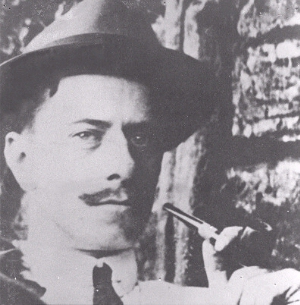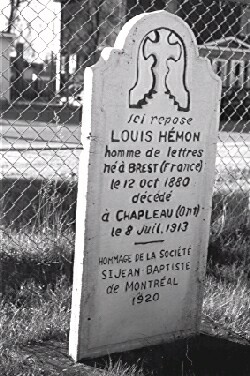Chapleau�s main claim to literary fame rests on the morbid co-incidence that two writers up and died near the town: Louis H�mon, born in France in 1880, the better known of the two is buried in Chapleau�s Old Roman Catholic Cemetery and the other, John Ceredigion Jones, born in Wales in 1883, is buried in Sultan.

Louis H�mon. Click the photo for more info.
H�mon, wrote the acclaimed novel, Maria Chapedelaine, a book based on what he had observed while working for a few months as a farmhand north of Lac St-Jean in Quebec.
When he died in 1913, H�mon was in his 34th year. He had just sent the final draft of Maria Chapedelaine to France for publication.
H�mon had come to Canada in the spring of 1912. Before that he had lived in England for 9 years, making a living writing short stories and articles for French periodicals. He also managed to publish a grim, realistic novel of life in London�s slums, Lizzie Blakestone. In 1909, his English wife bore him a daughter, Lydia Kathline. When his wife died two years later, he placed his infant daughter with his sister in France and set out to make a new life for himself in Canada.
It was the summer of 1913, the last summer before the Great War revealed the murderous nature of the 20th century. H�mon was travelling west in search of material for future books. His habit was to hop freight trains or walk along the railway right-of-way. On July 8, 1913, a couple of miles west of Chapleau, Louis H�mon was hit and killed by a train driven by John Stokes.
The body was brought back to Chapleau for burial. Later, the marble grave marker that can still be seen in the old Roman Catholic Cemetery on Birch Street was erected. There is some doubt that this marker was placed exactly in the right spot.

Maria Chapedelaine appeared in print after H�mon�s death, first as a serial in France in Le Temps (1914) and then as a book in Montreal (1916). It made little impression at the time, perhaps because the world was distracted by the Great War (1914-1918).
In 1921, the French literary critic Daniel Hal�vy drew attention to the strengths of H�mon�s writing and the novel belatedly became a success in France. That same year, two English translations made the novel available to English-speaking readers. Maria Chapedelaine was on its way to becoming a classic. In 1938, Louis H�mon�s sister and daughter travelled from France to be present at the unveiling of a commemorative bronze plaque near the C.P.R. station in Chapleau.
John Ceredigion Jones, the other writer whose final resting place is found in the Greater Chapleau Area, goes, perhaps justifiably, uncelebrated in the world of letters (though his story did make the Toronto Star Weekly in the November 10, 1956, edition in an article written by J.E. Belliveau).
John Ceredigion Jones was one of eleven children of a Welsh farmer-blacksmith. Restless and chronically poor, Jones travelled a great deal throughout North America after arriving in Canada in 1904. Unlike H�mon, he was not a published writer �apart from argumentative letters-to-the-editor and a few undistinguished poems which also sometimes found their way into the newspapers. One of his poems, �The Returning Man�, was printed in 1919 or 1920 in the Calgary Albertan.
Around the same time that Jones�s poem was published in Calgarry, architect John A. Pearson was overseeing the building of the Peace Tower (1919-1927) in Ottawa. This soaring gothic monument was to be the focal-point of the new Centre Block on Parliament Hill and a memorial to the Canadian casualties of the Great War. As an inscription to be carved in stone over the
entrance to the Memorial Chamber of the Peace Tower, Pearson
chose the lines,
�All�s well for over there among his peers
A Happy Warrior sleeps.�

The Peace Tower in Ottawa. Click the picture for more info.
Pearson could not remember the source of these lines. At the time, the lines seemed so compelling that a search was undertaken to locate their author. The minions of British prime Minister Stanley Baldwin and Canadian Prime Minister Mackenzie King and swarms of librarians could not locate the source. Then, in a letter-the editor of the Montreal Herald, a J.C. Jones of Montreal claimed that he had written the lines. To convince skeptical authorities, Jones produced a clipping from the Calgary Albertan. The Department of National Defence eventually accepted Jones�s claim and paid his $8.00. The year was 1939.
In 1950, Jones, aged, 67, jumped from a train at Sultan and got a job at the sawmill. A few days later, a heart attack killed him. The Rev. Strapp of Trinity United Church, Chapleau, presided over the interment of this stranger in Sultan�s burial ground. Eventually, a brother was found in Wales and the mysterious corpse�s one claim to fame �two lines of poetry�became known.
(Written by George Evans, largely based on material found in the book, Pioneering in Northern Ontario by Vince Crichton.)